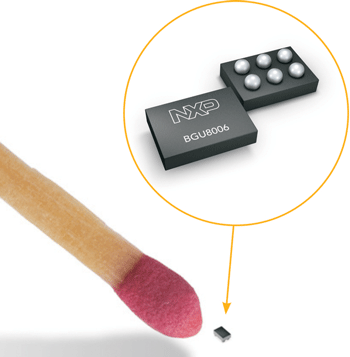- News
20 June 2012
NXP’s 0.65mm x 0.44mm x 0.2mm SiGe:C GPS LNAs offer 0.60dB noise figure
NXP Semiconductors N.V. of Eindhoven, The Netherlands, which provides mixed-signal and standard product solutions, has unveiled the BGU8006 low-noise amplifier, which is claimed to be the smallest GPS low-noise amplifier (LNA) on the market, designed for very small portable devices.
 Available in a wafer-level chip-scale package (WLCSP), the latest GPS LNAs have a footprint of just 0.65mm x 0.44mm x 0.2mm and require only two external components, saving 38% in PCB space compared to the smallest solution on the market, it is reckoned. With a very low noise figure of 0.60dB, the LNAs aid reception for weak GPS signals by dynamically suppressing strong cellular and WLAN transmit signals. NXP is showing the BGU800x series LNAs in booth 607 at the 2012 IEEE MTT-S International Microwave Symposium (IMS) in Montreal, Canada (17–22 June).
Available in a wafer-level chip-scale package (WLCSP), the latest GPS LNAs have a footprint of just 0.65mm x 0.44mm x 0.2mm and require only two external components, saving 38% in PCB space compared to the smallest solution on the market, it is reckoned. With a very low noise figure of 0.60dB, the LNAs aid reception for weak GPS signals by dynamically suppressing strong cellular and WLAN transmit signals. NXP is showing the BGU800x series LNAs in booth 607 at the 2012 IEEE MTT-S International Microwave Symposium (IMS) in Montreal, Canada (17–22 June).
“Smartphones, tablets, personal navigation devices and automotive telematics applications all suffer from communication delays when network reception is poor, and have to wait for data to refresh as the GPS searches for satellite signal,” says Erick Olsen, marketing director, RF small signal product line. “Our new BGU8006 LNA helps to maintain optimal GPS signal reception for as long as possible – on a chip that is so small, it isn’t even visible to the naked eye,” he adds. “As GPS functionality becomes ubiquitous, the ability to deliver better accuracy and faster Time to First Fix will vastly improve user experience and enable operators to provide more sophisticated Location Based Services down the line.”
The BGU8006 LNA uses adaptive biasing techniques – enabled by NXP’s QuBIC4Xi SiGe:C BiCMOS process technology – to instantly detect any output power from jammers, and compensate by temporarily increasing the current. Adaptive biasing dynamically suppresses strong cellular, WLAN and Bluetooth signals, which can drive typical GPS LNAs into compression, lowering gain, generating intermodulation and harmonics that can overpower weak signals, and causing poor GPS reception. With the BGU8006, adaptive biasing improves linearity with a 10dB better IP3 under –40 to –20dBm jamming conditions and provides effective GPS output with jammer power up to –15dBm.
As well as suiting space-constrained applications, the BGU8006’s WLCSP technology minimizes parasitic inductance because there are no leads, bond wires or interposer connections, and optimizes package size, cost and thermal characteristics. In addition to the BGU8006, NXP also offers the BGU8007 LNA in a 1.45mm x 1.0mm x 0.5mm 6-pin leadless SOT886 package. Both LNAs require only one external matching inductor and one external decoupling capacitor for easy design-in and savings in component costs and PCB area, says NXP.
The BGU800x series LNAs are suited to a wide range of applications using GPS technology, including smartphones, feature phones, tablets, personal navigation devices (PNDs), digital still cameras (DSCs), digital video cameras (DVCs), RF front-end modules for phones, and complete GPS chipset modules. For automotive telematics applications such as emergency call (eCall) and toll collection systems, NXP also offers the BGU7004 and BGU7008, which are AEC-Q100 qualified.
The BGU8007 LNA is currently available. Qualification samples of the BGU8006 will be available in Q3/2012, with volume production during Q4/2012.
